chicago
 The headline read “Wedding Gown To Be Her Shroud.” The newspaper article was about a horrible tragedy, that took place just four days after the wedding of my husband, Bob’s 6th cousin 3 times removed, Ruth Schulenberg to Wilberd Youngman. The wedding took place on November 26, 1913, and was a large social affair for the smaller town of Tolono, Illinois, population of about 700, at the time. Ruth Schulenberg, was the daughter of Mr and Mrs Henry Schulenberg, and was a graduate of Saint Mary’s of the Wood where she was a member of a prominent sorority. Wilberd Youngman employed as a draughsman by the Burr Company of Champaign, Illinois. The wedding took place at Saint Patrick’s Catholic Church in Tolono.
The headline read “Wedding Gown To Be Her Shroud.” The newspaper article was about a horrible tragedy, that took place just four days after the wedding of my husband, Bob’s 6th cousin 3 times removed, Ruth Schulenberg to Wilberd Youngman. The wedding took place on November 26, 1913, and was a large social affair for the smaller town of Tolono, Illinois, population of about 700, at the time. Ruth Schulenberg, was the daughter of Mr and Mrs Henry Schulenberg, and was a graduate of Saint Mary’s of the Wood where she was a member of a prominent sorority. Wilberd Youngman employed as a draughsman by the Burr Company of Champaign, Illinois. The wedding took place at Saint Patrick’s Catholic Church in Tolono.
After their wedding, the young couple was on their honeymoon, in Kokomo, Indiana, where they had attended church at the Kokomo Catholic Church. Following the church service, they were on their way to a big wedding dinner in their honor at the country residence of a neighbor of Youngman’s cousin, Edward Grishaw, who was 
 transporting the couple in a closed carriage. As the carriage began its crossing of the tracks of the Lake Erie and Western Railway, Grishaw failed for look for trains, and pulled out in front of the Lake Erie train going full speed. The train ripped through the car, and by the time the train could stop and the crew reached the car’s occupants, Ruth Schulenberg and Edward Grishaw were dead. Wilberd Youngman was critically injured, and not expected to live.
transporting the couple in a closed carriage. As the carriage began its crossing of the tracks of the Lake Erie and Western Railway, Grishaw failed for look for trains, and pulled out in front of the Lake Erie train going full speed. The train ripped through the car, and by the time the train could stop and the crew reached the car’s occupants, Ruth Schulenberg and Edward Grishaw were dead. Wilberd Youngman was critically injured, and not expected to live.
Amazingly, Wilberd Youngman did live…for eleven months. Youngman was taken to a hospital in Chicago, but his prognosis was grim. People just don’t come back from being hit by a train that ripped their car apart, and yet he was still alive, and actually recovering from his injuries…the visible injuries anyway. Youngman had lost so much that November day, and he was struggling to move forward. Ruth Schulenberg had been his soulmate, and his very best friend. She was the love of his life, and he knew there could never be another woman for him. Wilberd Youngman was not a man who would commit suicide, but he also could not recover from this deepest injury…the one that broke his heart. Slowly, over the eleven months that followed the saddest day of  his life, Wilberd Youngman dwindled away. it wasn’t a refusal of food and water, but rather a refusal to go on without his precious Ruth. Finally, on October 24, 1914, just short of 11 months after that awful day…November 30, 1913, Wilberd Youngman could no longer go on living, and so, with his parents by his side, he simply passed away. The final cause of death was listed as a broken heart. That, to me was the saddest cause of death I had ever heard. Because of the loss of his wife, Wilberd simply had no desire to live either. He tried to recover…physically, but his heart was no longer in it, and he finally just gave up and quit trying. The Honeymoon Tragedy had finally claimed it’s last victim.
his life, Wilberd Youngman dwindled away. it wasn’t a refusal of food and water, but rather a refusal to go on without his precious Ruth. Finally, on October 24, 1914, just short of 11 months after that awful day…November 30, 1913, Wilberd Youngman could no longer go on living, and so, with his parents by his side, he simply passed away. The final cause of death was listed as a broken heart. That, to me was the saddest cause of death I had ever heard. Because of the loss of his wife, Wilberd simply had no desire to live either. He tried to recover…physically, but his heart was no longer in it, and he finally just gave up and quit trying. The Honeymoon Tragedy had finally claimed it’s last victim.
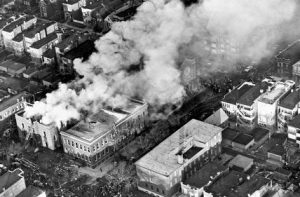 Prior to December 1, 1958, fire drills were not normal procedure, and in fact, were not held at all. No one knew how important fire drills were, even though they knew the dangers of fire, and just how deadly it was. Mainly, they did not realize just how important fire drills were to the safe evacuation of people from a burning building. Prior to that day, when there was a fire, those who knew about the fire ran, and most didn’t think about raising the alarm to let others know. This was especially true in schools, where in reality, fire drills were exponentially more important, because the drill made an emergency seem like just another drill, and could be carried out, before the smell of smoke even arrived in the rooms of the school. Prior to December 1, 1958, the schools had an alarm, but all too often, setting it off was the last thing on the minds of the people in charge…mostly due to their own panic. Later it would be determined that with practice, an emergency situation could be handled, and the people evacuated quickly, if the procedure was simply a practiced maneuver that everyone knew and automatically executed.
Prior to December 1, 1958, fire drills were not normal procedure, and in fact, were not held at all. No one knew how important fire drills were, even though they knew the dangers of fire, and just how deadly it was. Mainly, they did not realize just how important fire drills were to the safe evacuation of people from a burning building. Prior to that day, when there was a fire, those who knew about the fire ran, and most didn’t think about raising the alarm to let others know. This was especially true in schools, where in reality, fire drills were exponentially more important, because the drill made an emergency seem like just another drill, and could be carried out, before the smell of smoke even arrived in the rooms of the school. Prior to December 1, 1958, the schools had an alarm, but all too often, setting it off was the last thing on the minds of the people in charge…mostly due to their own panic. Later it would be determined that with practice, an emergency situation could be handled, and the people evacuated quickly, if the procedure was simply a practiced maneuver that everyone knew and automatically executed.
So, what led up to the fire drill revelation? Basically, it was due to a fire at a grade school in Chicago that killed 90 students on this day in 1958. Our Lady of Angels School was operated by the Sisters of Charity in Chicago. In 1958, there were well over 1,200 students enrolled at the school, which occupied a large, old building. In 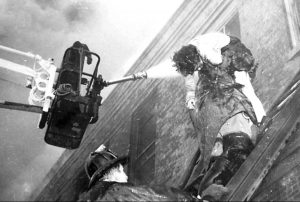 those days, little was done in the way of fire prevention. The building did not have any sprinklers and no regular preparatory drills were conducted. Those two factors combined, led to disaster when a small fire broke out in a pile of trash in the basement, and quickly burned out of control.
those days, little was done in the way of fire prevention. The building did not have any sprinklers and no regular preparatory drills were conducted. Those two factors combined, led to disaster when a small fire broke out in a pile of trash in the basement, and quickly burned out of control.
It is thought that the fire began about 2:30 pm. Within minutes, several teachers on the first floor smelled it. These teachers led their classes outside, but because it was never practiced, no one thought to sound a general alarm. The school’s janitor discovered the fire at 2:42 pm, and shouted for the alarm to be rung…but by then, at least ten precious minutes had passed since the fire started. Time to evacuate was quickly running out. Unfortunately, the janitor was either not heard or the alarm system did not operate properly. The students in the classrooms on the second floor were completely unaware of the rapidly spreading flames beneath them. It took a few more minutes for the fire to reach the second floor. By this time, panic had overtaken the students and teachers. Some panic stricken students jumped out windows to escape. I can only imagine the horror the firefighters must have felt as the roll up to the scene to find students hanging from the second floor windows, as they ran to try to catch them as they fell. Although the firefighters who were arriving on the scene tried to 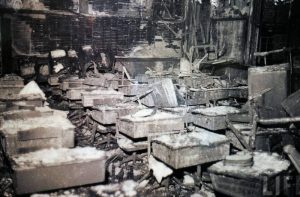 catch them, some were injured. Firefighters also tried to get ladders up to the windows. One quick-thinking nun had her students crawl under the smoke and roll down the stairs, where they were rescued. Other classes remained in their rooms, praying for help. There was no protocol…no routine…and for 90 students and 3 nuns, no chance of survival. Several hours later, when the fire was finally extinguished, the authorities found the 90 students and 3 nuns in the ashes of the classrooms. Sadly, it is the horrific “lessons” that trigger the quickest move to change, and this fire was no different. These days, when students hear the alarm…which is automatic when smoke is detected, they line up, and leave the school in a calm and orderly manner. Fire drills save lives.
catch them, some were injured. Firefighters also tried to get ladders up to the windows. One quick-thinking nun had her students crawl under the smoke and roll down the stairs, where they were rescued. Other classes remained in their rooms, praying for help. There was no protocol…no routine…and for 90 students and 3 nuns, no chance of survival. Several hours later, when the fire was finally extinguished, the authorities found the 90 students and 3 nuns in the ashes of the classrooms. Sadly, it is the horrific “lessons” that trigger the quickest move to change, and this fire was no different. These days, when students hear the alarm…which is automatic when smoke is detected, they line up, and leave the school in a calm and orderly manner. Fire drills save lives.
 Years ago, when the telephone first came out, the only way to call someone, if they had a phone, that is, was to go through the operator. Basically, you picked up your phone, and often, cranked a ringer to get the attention of the operator, and then told them who you wanted to talk to. The operator would then connect you with the person you were calling by way of a switchboard. Of course, that meant that the operator could also stay on the line and listen to the whole conversation, if she chose to do so. The switchboard operator was needed to make any call except if two people had a party line.
Years ago, when the telephone first came out, the only way to call someone, if they had a phone, that is, was to go through the operator. Basically, you picked up your phone, and often, cranked a ringer to get the attention of the operator, and then told them who you wanted to talk to. The operator would then connect you with the person you were calling by way of a switchboard. Of course, that meant that the operator could also stay on the line and listen to the whole conversation, if she chose to do so. The switchboard operator was needed to make any call except if two people had a party line.
Many people have no idea what a party line is, but my friend Gale Dugger Oskolkoff had one when her family lived in the Casper area, and her, her sisters, and I used to have a great time listening in on the calls that were made to a girl who had the unfortunate position of being a teenaged girl with a boyfriend and a party line. She use to get so mad at us. I don’t even know her name, but if she could have, I think she would have reached through the phone and choked us. Of course, I feel sorry for her now, because there was pretty much no privacy in her love life, but it was fun…for us anyway.
Before long, party lines became a thing of the past, and while direct distance dialing came into being before party lines went out, direct distance dialing was a brand new technology on November 10, 1951, when it was first offered on trial basis at Englewood, New Jersey, to 11 selected major cities across the United States. This service grew rapidly across major cities during the 1950s. The first direct-dialed long-distance telephone calls were possible in the New Jersey communities of Englewood and Teaneck. Customers of the ENglewood 3, ENglewood 4 and TEaneck 7 exchanges, who could already dial New York City and area, were able to dial 11 cities across the United States, simply by dialing the three-digit area code and the seven-digit number, which at the time consisted of the first two letters of the central office name and five digits. On November 10, 1951, Englewood Mayor M. Leslie Denning made the first customer-dialed long distance call, to Mayor Frank Osborne of Alameda, California.
The eleven destinations at that time were:

617: Boston, Massachusetts
312: Chicago, Illinois
216: Cleveland, Ohio
313: Detroit, Michigan
414: Milwaukee, Wisconsin
415: Oakland, California
215: Philadelphia, Pennsylvania
412: Pittsburgh, Pennsylvania
401: Providence, Rhode Island
916: Sacramento, California
318: San Francisco – San Francisco required the special code 318 for temporary routing requirements
Many other cities could not be included, as they did not yet have the necessary toll switching equipment to handle incoming calls automatically on their circuits. As with any technology, these changes take time to implement. Other cities still had either a mixture of local number lengths or were all still six-digit numbers. Montreal, Quebec and Toronto, Ontario in Canada, for example, had a mix of six and seven-digit numbers from 1951 to 1957, and did not have direct distance dialing until 1958. Whitehorse, Yukon, had seven-digit numbers from 1965, but the necessary switching equipment was not in place locally until 1972.

These days, all this seems completely archaic, considering the fact that even the phone lines that were installed on poles and underground are almost not necessary in today’s world. With the implementation of wireless…everything, we no longer need to have a phone line to have a phone, and in fact a home phone is not necessary for most people, because a cellular phone can be taken with us where ever we go, so we never need to miss a call, unless our work does not allow us to have the phone with us. Phones have come a long way since the days of switchboards, operators, and phone lines, and I think most of us would agree that it’s better now, although there are those who like to be disconnected.

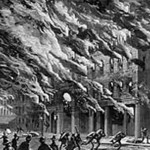 On October 8, 1871, one of the worst fires in history started in Chicago. Rumor has it that a cow kicked over a lantern in a barn, and the ensuing fire killed more than 250 people, left 100,000 homeless, destroyed more than 17,400 structures and burned more than 2,000 acres. According to the legend, the fire broke out after the cow, belonging to Mrs. Catherine O’Leary, kicked over a lamp, setting first the barn, located on the property of Patrick and Catherine O’Leary at 137 Dekoven Street on the city’s southwest side, then the whole city on fire. You’ve probably heard some version of this story yourself. People have been blaming the Great Chicago Fire on the cow and Mrs. O’Leary, for more than 130 years. Mrs. O’Leary denied this charge. Recent research by Chicago historian Robert Cromie has helped to debunk this version of events.
On October 8, 1871, one of the worst fires in history started in Chicago. Rumor has it that a cow kicked over a lantern in a barn, and the ensuing fire killed more than 250 people, left 100,000 homeless, destroyed more than 17,400 structures and burned more than 2,000 acres. According to the legend, the fire broke out after the cow, belonging to Mrs. Catherine O’Leary, kicked over a lamp, setting first the barn, located on the property of Patrick and Catherine O’Leary at 137 Dekoven Street on the city’s southwest side, then the whole city on fire. You’ve probably heard some version of this story yourself. People have been blaming the Great Chicago Fire on the cow and Mrs. O’Leary, for more than 130 years. Mrs. O’Leary denied this charge. Recent research by Chicago historian Robert Cromie has helped to debunk this version of events.
From that event, came a proclamation by President Calvin Coolidge that the first National Fire Prevention Week be held on October 4-10, 1925. The move started a tradition recognizing October as Fire Prevention Month, the first week in October becoming Fire Prevention Week, and the second Saturday becoming Home Fire Drill Day. Fire Prevention Week is observed on the Sunday through Saturday period in which October 9 falls, in commemoration of the Great Chicago Fire, which began October 8, 1871, and did most of its damage October 9. The month and week are filled with information designed to teach people how to prevent fire disasters, as well as activities for children designed to teach them too.
None of us wants to have to really get out of a home fire situation, but it is really important that people know how in the unfortunate event that their home does catch on fire. So, the last part of Fire Prevention Month is Home Fire Drill Day, which is today, October 14, 2017. It is a day to plane your escape routes, and practice 
 getting out, especially with children. It is designed also, to point out where you might be vulnerable and what equipment might be needed to make your home safe, such as smoke alarms, fire extinguishers, and escape ladders. Whether you have little ones or not, it is so easy to get confused or disoriented in a fire emergency. Just like in the schools, routine practice makes every step of a fire evacuation a habit, and it could very likely save your life or that of your family. Why not start today?
getting out, especially with children. It is designed also, to point out where you might be vulnerable and what equipment might be needed to make your home safe, such as smoke alarms, fire extinguishers, and escape ladders. Whether you have little ones or not, it is so easy to get confused or disoriented in a fire emergency. Just like in the schools, routine practice makes every step of a fire evacuation a habit, and it could very likely save your life or that of your family. Why not start today?
 For some reason, there are certain areas on the United States, and the world, where earthquakes are…unexpected. There are just no real fault lines in these places, and no man-made reasons for it, like mining or drilling. So often people think they live in an area that is completely safe from an earthquake. Nevertheless, that does not mean that an earthquake can’t happen, as the people of Charleston, South Carolina found out on August 31, 1886.
For some reason, there are certain areas on the United States, and the world, where earthquakes are…unexpected. There are just no real fault lines in these places, and no man-made reasons for it, like mining or drilling. So often people think they live in an area that is completely safe from an earthquake. Nevertheless, that does not mean that an earthquake can’t happen, as the people of Charleston, South Carolina found out on August 31, 1886.
The first indicator that something strange was going on, came on August 27 and 28, when foreshocks were felt in Summerville, South Carolina, where my first cousin once removed, Stephanie Willard and her family live. While the tremors were odd, the people of the area didn’t think they were a warning for what was coming. Then, at 9:51pm on August 31, the rumbling began. The 7.6 magnitude quake was felt as far away as Boston, Chicago and Cuba. Buildings as far away as far away as Ohio and Alabama were damaged. But, it was Charleston, South Carolina, that took the biggest hit from the quake. Almost all of the buildings in town were seriously damaged. About 14,000 chimneys fell from the earthquake’s shaking. It caused multiple fires, and  water lines and wells were ruptured. The total damage was in excess of $5.5 million, which would be about $112 million today.
water lines and wells were ruptured. The total damage was in excess of $5.5 million, which would be about $112 million today.
While that was a disaster in itself, it was the loss of life that was felt the worst. More that 100 people lost their lives that fateful day, and countless others were injured, in what is still the largest recorded earthquake in the history of the southeastern United States. The quake damaged as many as 2,000 buildings, including buildings as far away as central Alabama, central Ohio, eastern Kentucky, southern Virginia and western West Virginia. The strange part about this quake is the fact that there were no apparent surface cracks as a result of this tremor, railroad tracks were bent in all directions in some locations. Acres of land were liquefied. This quake remained a mystery for many years since there were no known underground faults for 60 miles in any direction. Then, as science and detection methods got better, scientists have recently uncovered a concealed fault along the coastal plains of Virginia and the Carolinas. While this fault is now known, scientists think that another quake of this magnitude remains highly  unlikely, though not impossible, in this location.
unlikely, though not impossible, in this location.
I guess I don’t quite understand that concept, except to say that if it is the only fault and has nothing to connect to, maybe there is less chance of a small tremor turning into a big quake, and maybe that is why they don’t expect another quake of that magnitude. Still, it is always good advise to realize that no place is immune to earthquakes. Oklahoma has found that out in recent years, as underground mining work has created quake situations that weren’t there before. It is still my hope that the Charleston area never has another quake like the one they had in 1886.

 Shipwrecks on the Great Lakes are not a totally uncommon event. Over the last 300 years, Lake Michigan has claimed countless ships, mostly in violent storms and bad weather, especially when the gales of November come in. Nevertheless, a few ships went down without even reaching open waters. One of those ships was the SS Eastland, which went down while docked between LaSalle and Clark Streets on the Chicago River. That site and that ship became the site of the greatest loss of life on the Great Lakes, and it wasn’t a fire, explosion, or act of war, but rather something far more strange.
Shipwrecks on the Great Lakes are not a totally uncommon event. Over the last 300 years, Lake Michigan has claimed countless ships, mostly in violent storms and bad weather, especially when the gales of November come in. Nevertheless, a few ships went down without even reaching open waters. One of those ships was the SS Eastland, which went down while docked between LaSalle and Clark Streets on the Chicago River. That site and that ship became the site of the greatest loss of life on the Great Lakes, and it wasn’t a fire, explosion, or act of war, but rather something far more strange.
The SS Eastland was built by the Michigan Steamship Company in 1902 and began regular passenger service later that year. In July 1903, the ship held an open house so the public could have a look. The sudden number of people, particularly on the upper decks, caused the Eastland to list so severely that water came in through the gangways where passengers and freight would be brought aboard. The ship was obviously top-heavy and this problem had to dealt with quickly, but these incidences continued to plague the ship. In 1905, the Eastland was sold to the Michigan Transportation Company. During the summer of 1906, the Eastland listed again as it transported 2500 passengers, and her carrying capacity was reduced to 2400. But in July 1912, the Eastland was reported as having once more listed to port and then to starboard while carrying passengers. In 1915, the LaFollette Seaman’s Act, which was created as a response to the Titanic not carrying sufficient lifeboats, was passed. The Seaman’s Act mandated that lifeboat space would no longer depend on gross tonnage, but rather on how many passengers were on board. However adding extra weight to the ship put top-heavy vessels like the Eastland at greater risk of listing. In fact, the Senate Commerce Committee was cautioned at the time that placing additional lifeboats and life rafts on the top decks of Great Lakes ships would make them dangerously unstable. This was a warning that the Senate Committee and the Eastland should have heeded.
On July 24, 1915, the Eastland once again fell victim to its top heavy design, and this time the outcome was disastrous. On that cool Saturday morning in Chicago, the Eastland and two other steamers were waiting to take on passengers bound for an annual company picnic in Michigan City, Indiana. For many of the employees of Western Electric Company’s Hawthorne Works, this would be the only holiday they would enjoy all year. A large number of these employees from the 200-acre plant in Cicero, Illinois were Czech Bohemian immigrants. Excitement was in the air as thousands of employees thronged along the river. Three ships would transport them across Lake Michigan to the picnic grounds in Indiana. The Eastland was slated to be the first ship boarded. That morning the Eastland was docked between LaSalle and Clark Streets on the Chicago River. As soon as passengers began boarding, Captain Harry Pedersen and his crew noticed that the ship was listing to port even though most passengers were gathered along the starboard. Attempts were made to right the vessel, but stability seemed uncertain. At 7:10am, the ship reached its maximum carrying capacity of 2572 passengers and the gangplank was pulled in.
As the captain made preparations to depart at 7:21am, the crew continued to let water into the ship’s ballast tanks in an attempt to stabilize the vessel. At 7:23am, water began to pour in through the port gangways. Within minutes, the ship was seriously listing but most passengers seemed unaware of the danger. I wondered how this could have continued to happen, until I saw this video, that explained it very well. By 7:27am, the ship listed so badly that passengers found it too difficult to dance so the orchestra musicians started to play ragtime instead to keep everyone entertained. Just one minute later, at 7:28am, panic set in. Dishes crashed off shelves, a sliding piano almost crushed two passengers, and the band stopped playing as water poured through portholes and gangways. In the next two minutes, the ship completely rolled over on its side, and settled on the shallow river bottom 20 feet below. Passengers below deck now found themselves trapped as water gushed in and heavy furniture careened wildly. Men, women and children threw themselves into the river, but others were trapped between decks, or were crushed by the ship’s furniture and equipment. The lifeboats and life jackets were of no use since the ship had capsized too quickly to access them. In the end, 844 people lost their lives, including 22 entire families. It was a tragedy of epic proportions.
Bystanders on the pier rushed to help those who had been thrown into the river, while a tugboat rescued passengers clinging to the overturned hull of the ship. An eyewitness to the disaster wrote: “I shall never be able to forget what I saw. People were struggling in the water, clustered so thickly that they literally covered 
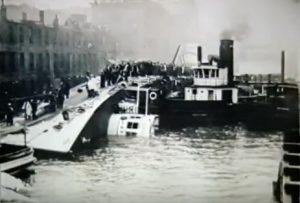 the surface of the river. A few were swimming; the rest were floundering about, some clinging to a life raft that had floated free, others clutching at anything that they could reach…at bits of wood, at each other, grabbing each other, pulling each other down, and screaming! The screaming was the most horrible of them all.” Yes, I’m sure that was the worst, and the loss of life was something that would never be forgotten…especially for an eye witness.
the surface of the river. A few were swimming; the rest were floundering about, some clinging to a life raft that had floated free, others clutching at anything that they could reach…at bits of wood, at each other, grabbing each other, pulling each other down, and screaming! The screaming was the most horrible of them all.” Yes, I’m sure that was the worst, and the loss of life was something that would never be forgotten…especially for an eye witness.

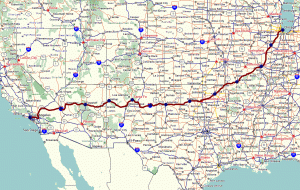 In years gone by, US Route 66 was also known as the Will Rogers Highway, the Main Street of America, or the Mother Road. It was one of the original highways within the US Highway System. US Highway 66 was established on November 11, 1926, with road signs erected the following year. The highway became one of the most famous roads in the United States, and originally ran from Chicago, Illinois, through Missouri, Kansas, Oklahoma, Texas, New Mexico, and Arizona before ending at Santa Monica, California, covering a total of 2,448 miles. It was highlighted by both the hit song “(Get Your Kicks) on Route 66” and the Route 66 television show in the 1960s, and later, “Wild Hogs.” After 59 years, on June 27, 1985, when the American Association of State Highway and Transportation Officials decertified the road and removed all its highway signs, and the famous Route 66 entered the realm of history.
In years gone by, US Route 66 was also known as the Will Rogers Highway, the Main Street of America, or the Mother Road. It was one of the original highways within the US Highway System. US Highway 66 was established on November 11, 1926, with road signs erected the following year. The highway became one of the most famous roads in the United States, and originally ran from Chicago, Illinois, through Missouri, Kansas, Oklahoma, Texas, New Mexico, and Arizona before ending at Santa Monica, California, covering a total of 2,448 miles. It was highlighted by both the hit song “(Get Your Kicks) on Route 66” and the Route 66 television show in the 1960s, and later, “Wild Hogs.” After 59 years, on June 27, 1985, when the American Association of State Highway and Transportation Officials decertified the road and removed all its highway signs, and the famous Route 66 entered the realm of history.
The idea of building a highway along this route was first mentioned in Oklahoma in the mid-1920s. It was a way to link Oklahoma to cities like Chicago and Los Angeles. Highway Commissioner Cyrus Avery said that it would also be a way of diverting traffic from Kansas City, Missouri and Denver. In 1926, the highway earned its official designation as Route 66. The diagonal course of Route 66 linked hundreds of mostly rural communities to the cities along its route. This was to allow farmers to have an easy transport route for grain and other types of produce for distribution to the cities. In the 1930s, the long-distance trucking industry used it as a way of competing with the railroad for dominance in the shipping market.
During the Dust Bowl years of the 1930s, Route 66 was the scene of a mass westward migration, when more than 200,000 people traveled east from poverty-stricken, drought-ridden areas of California. John Steinbeck immortalized the highway in his classic 1939 novel “The Grapes of Wrath.” Beginning in the 1950s, the building of a massive system of interstate highways made older roads increasingly obsolete, and by 1970, modern four lane 
 highways had bypassed nearly all sections of Route 66. In October 1984, Interstate 40 bypassed the last original stretch of Route 66 at Williams, Arizona. According to the National Historic Route 66 Federation, drivers can still use 85 percent of the road, and Route 66 has become a destination for tourists from all over the world. After watching Wild Hogs, Bob and I became two of the many tourists who did drive a little bit of it when we drove to Madrid, New Mexico as part of our vacation, doing all the touristy things.
highways had bypassed nearly all sections of Route 66. In October 1984, Interstate 40 bypassed the last original stretch of Route 66 at Williams, Arizona. According to the National Historic Route 66 Federation, drivers can still use 85 percent of the road, and Route 66 has become a destination for tourists from all over the world. After watching Wild Hogs, Bob and I became two of the many tourists who did drive a little bit of it when we drove to Madrid, New Mexico as part of our vacation, doing all the touristy things.
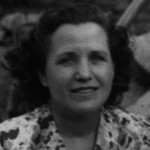 I have been reading my Great Aunt Bertie Schumacher’s journal for a while now, and every time I pick it up I find something new. She started her journal by talking about how any writer can become famous in time, simply by observing the events around them and writing about those events, how they made people feel, and what happened because of those events. As a writer myself, I began to think about what she said, because there really is a vast difference, I think, between a writer and a reporter. A reporter simply tells the events as they happened, but a writer elaborates on the events, the people involved, and their feelings. There are reporters who are writers, obviously, but I think it would be very hard for a writer not to interject their thoughts and feelings into a report.
I have been reading my Great Aunt Bertie Schumacher’s journal for a while now, and every time I pick it up I find something new. She started her journal by talking about how any writer can become famous in time, simply by observing the events around them and writing about those events, how they made people feel, and what happened because of those events. As a writer myself, I began to think about what she said, because there really is a vast difference, I think, between a writer and a reporter. A reporter simply tells the events as they happened, but a writer elaborates on the events, the people involved, and their feelings. There are reporters who are writers, obviously, but I think it would be very hard for a writer not to interject their thoughts and feelings into a report.
Aunt Bertie wanted to tell a little bit about the things that were going on in their time. Still, she could not help but put into words how she felt about the events of the day. She mentioned that the first Kindergarten was formed in 1873. At that time there were only about 200 high schools in the entire country, but by 1900 there were 6000, along with colleges that were heavily endowed by the Rockefeller, Stanford, and Vanderbilt families. Fisk College for “blacks” came into being. Women were coming to the foreground. Football became a part of college life. You could become a doctor in four months…later it took three years, and we all know it takes much longer now. At that time, 98% of children were in the grades. Aunt Bertie mentions that it was thought that education was a cure all. Authors like Emily Dickinson, Bret Hart, and Mark Twain tried to enrich the world. There were streetcar and yacht races, P.T Barnum Circus, Dwight Moody held mass revivals, and McGuffy’s Reader taught moral lessons. And then she tells about the thing that bothers her the most, when she said, “But all this did not abolish CHILD LABOR!”  It seemed to Aunt Bertie that there were so many changes that the nation was seeing, but the one thing that appalled her the most at the time, was still there, and still endangering the lives of children. It was so hard for her to imagine that with everything else moving with such monumental steps toward a more modern civilization, that was so much more educated, that no one could stop child labor. In fact it seemed to her that no one noticed it, or even cared at all.
It seemed to Aunt Bertie that there were so many changes that the nation was seeing, but the one thing that appalled her the most at the time, was still there, and still endangering the lives of children. It was so hard for her to imagine that with everything else moving with such monumental steps toward a more modern civilization, that was so much more educated, that no one could stop child labor. In fact it seemed to her that no one noticed it, or even cared at all.
Her writings picture disasters, such as the panic in 1873, at the height of the reconstruction of the 1870’s…widespread unemployment, bankruptcy of many people, and failure of businesses, the Great Chicago fire and fires in Wisconsin, Boston, and other places that caused the failure of Insurance Companies who did not have enough Reserves to cover all of these disasters, railroad strikes and violence. Then she mentions what she terms “the sins of society”, one million people living in New York slums…ten to fifteen people in three rooms. The thought of so many people being forced to live in such appalling conditions tore at Aunt Bertie’s heart. Somehow, these things just should not be, and yet this was the world we were living in at that time.
Aunt Bertie wanted to tell about the things that were changing in our world, and how many improvements those changes were making to the world, but her tender heart just couldn’t get past the horrible injustices she could still see. There are lessons to be learned from her writings. Lessons of compassion, kindness, charity, and love for our fellow man. All too often we are so busy working on the improvements we want to make in our lives, society, and our  world in general, that we forget about how those things could affect the lives of others. The greed of the factory owners could not see past the profit to what their child laborers were suffering. Many changes have come from the horrors of the past. Child labor laws now protect our children, and as an insurance agent, I know that companies must hold enough in reserve to cover disastrous losses, and that while no insurance company is completely safe from failure, there is far less chance of it these days because of those reserves. While those days and events tore at Aunt Bertie’s tender heart, maybe society wasn’t totally deaf to the plight of the people after all.
world in general, that we forget about how those things could affect the lives of others. The greed of the factory owners could not see past the profit to what their child laborers were suffering. Many changes have come from the horrors of the past. Child labor laws now protect our children, and as an insurance agent, I know that companies must hold enough in reserve to cover disastrous losses, and that while no insurance company is completely safe from failure, there is far less chance of it these days because of those reserves. While those days and events tore at Aunt Bertie’s tender heart, maybe society wasn’t totally deaf to the plight of the people after all.
 With graduation behind us for another year, the thoughts of many graduates turn to the traditional graduation trip. It is supposed to be the first step into real freedom the young adult takes. The trips can be as varied as the graduate taking them, and of course, the cost they can afford. My thoughts go back to my own graduation trip. I felt very blessed to be one of the few that got to take such a trip. When I graduated, the graduation trip was not the common thing to do, and in fact, I don’t know of any of my friends that took one. Nevertheless, my parents wanted to give me something special, while not just sending me off alone into the unknown. So, they arranged for me to fly out to my older sister, Cheryl’s house in Plattsburgh, New York, for the Christmas and New Years holidays.
With graduation behind us for another year, the thoughts of many graduates turn to the traditional graduation trip. It is supposed to be the first step into real freedom the young adult takes. The trips can be as varied as the graduate taking them, and of course, the cost they can afford. My thoughts go back to my own graduation trip. I felt very blessed to be one of the few that got to take such a trip. When I graduated, the graduation trip was not the common thing to do, and in fact, I don’t know of any of my friends that took one. Nevertheless, my parents wanted to give me something special, while not just sending me off alone into the unknown. So, they arranged for me to fly out to my older sister, Cheryl’s house in Plattsburgh, New York, for the Christmas and New Years holidays.
I had never flown, much less flown alone, so this was a big deal for me! My flight was to take me to Chicago, Illinois, where I would change planes and fly on into New York City. My sister and her husband, at the time, would pick me up in New York City. I was very excited about this trip…and I felt very grown up, but at the same time a lot like a Kindergarten child on the first day of school. It was a really tough place to be. The flight was not really the thing that I was concerned about, but rather the change of flights. I believe I had 45 minutes or so between the flights, and I was worried that I would not get there in time.
When my flight arrived in Chicago, and after my initial surprise at the fact that the runway crossed over the highway, which I found very cool by the way, I began my journey over to the connecting flight’s gate…running!!! I’m quite sure I looked very much like the scared Kindergarten child I felt like, but that was something I didn’t really care about at the time. The thought of missing my flight and trying to figure out what to do about that all by myself, in Chicago, was not a prospect I relished,…so I ran. When I arrived at my gate, I found myself 30 minutes early…with nothing to do.
I thought about all the airport that I had run through and not bothered to look at…with a little bit of regret. Still, with only the 30 minutes left, I decided that I probably should stay right where I was. The rest of the trip went very smoothly and I had a wonderful time with my sister and her family. I think I really did some growing up at that time, and I can honestly say that I don’t run to the connecting flights anymore, although there have been a couple that we cut a little close. My graduation trip was a trip I will always remember, and forever be grateful to my parents for sending me on.

